60 Top Customer Service Statistics For 2024
Want to learn more about the state of customer service this year? You’re in the right place.
We’ve curated a list of the most important customer service statistics from all of the latest industry reports.
These stats shed light on how consumer expectations are changing when it comes to customer support and provide valuable insights that will help to inform your CX strategy for the year ahead.
Editor’s top picks
- The customer service software market has reached over $24.6 billion (Gartner)
- 80% of customer service departments will increase budgets this year (Zendesk)
- 82% of customer service leaders think more customers now expect personalized support (Intercom)
- 88% of consumers believe customer service matters as much as the product (Salesforce)
- Almost half of all surveyed consumers have switched brands for better customer service (Salesforce)
- Phone is still the number one customer service channel (Salesforce)
- Video is the fastest-growing customer service channel
- 45% of surveyed customer service leaders say they use AI (Salesforce)
- 72% of surveyed customer service leaders say expanding AI usage will be important this year (Zendesk)
General customer service statistics
Let’s kick things off with some general customer service statistics that reveal the current size and shape of the industry, as well as some of the most notable trends of the last year.
1. The customer service and support software market is over $24.6 billion
The market reached that value in 2020 following a 12.9% year-over-year (YoY) growth. This growth was primarily driven by the pandemic, which forced marketers to lean more heavily on software to find new ways to engage with their clients online while also supporting their remote workers.
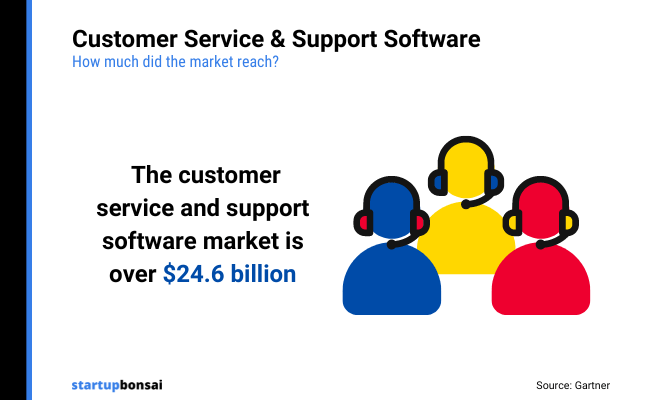
Source: Gartner
2. 60% of customer service professionals say customer expectations increased during the pandemic, but…
In the latest Salesforce survey of customer service pros, respondents noted that consumer expectations regarding customer service are higher now than they were pre-pandemic.
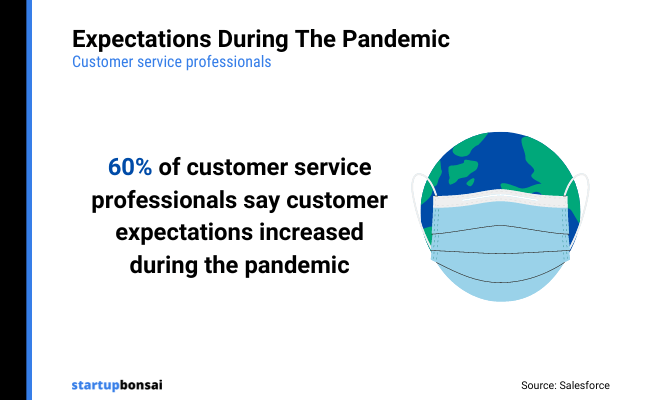
Source: Salesforce
3. …76% of customers are satisfied with the service they’ve received over the last year
While customer expectations amongst the public may be higher now than a few years ago, it looks like the vast majority of companies are stepping up and meeting those expectations.
Over three-quarters of customers surveyed by Zendesk said they were happy with the level of service they’d received over the last year. And 57% noticed a marked improvement in customer support.
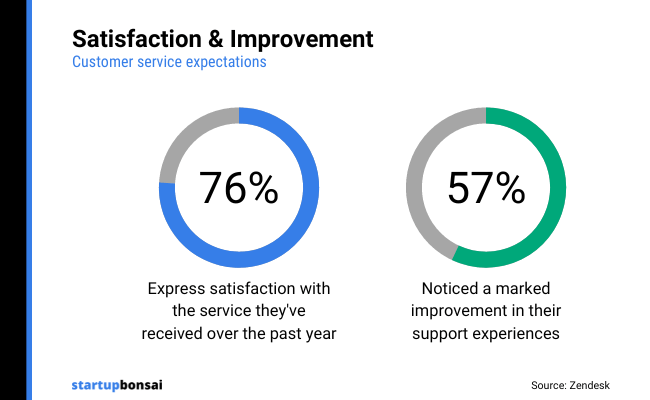
Source: Zendesk
4. 56% of consumers feel positive about their support interactions over the last year
Building on the last point, this statistic reinforces the idea that brands have stepped up their games when it comes to customer support. 56% of surveyed consumers said they felt positive about their interactions with customer service reps this year, 25% said they felt neutral, and only 19% said they felt negative.
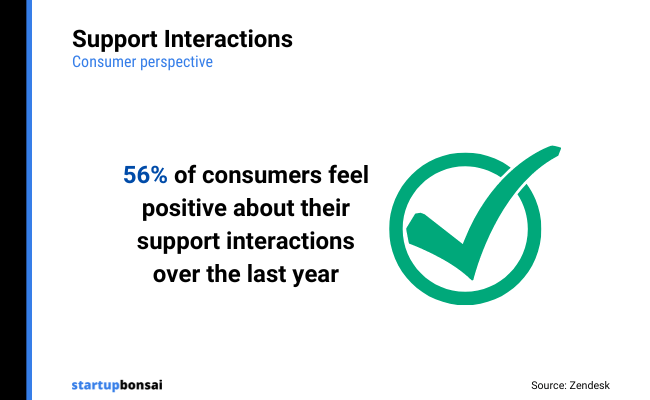
Source: Zendesk
5. 80% of decision-makers plan to increase their customer support budget next year
Brands continue to invest heavily in customer service. Around four-fifths plan to increase their budget for customer support over the coming year.
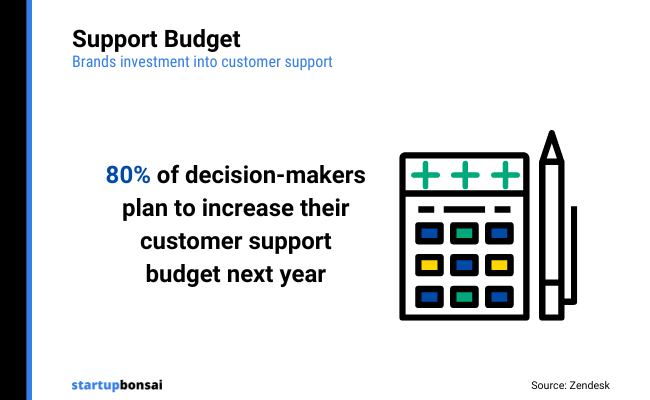
Source: Zendesk
6. 59% of customer service professionals think speed and quality are equally important when it comes to customer service
Customer service departments continue to have to strike a balance between providing quality support and efficiency.
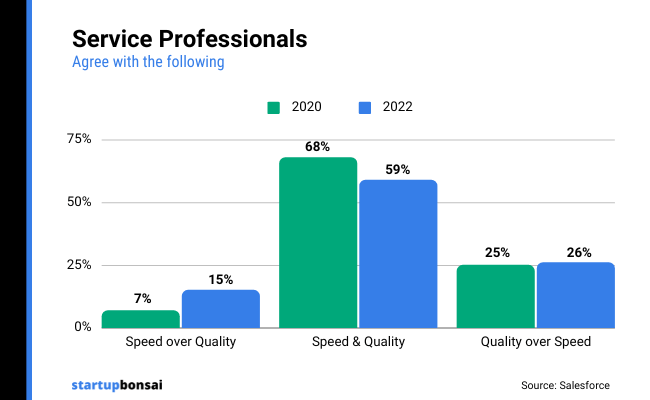
While most surveyed pros say the two are equally important, the number that said speed is more important than offering quality customer service jumped from 7% in 2020 to 15% in 2022. This speed is definitely becoming more important as businesses prioritize efficiency in the current economic climate.
Source: Salesforce
7. 82% of customer support leaders say customer expectations for personalized support have increased over the last year
One of the main trends of the last year or so has been the shift to personalized support. This is something that consumers now expect from the brands they interact with, and 89% of support leaders think personalized support will be an important competitive differentiator this year.
Source: Intercom
8. …but 54% lack the right tools to offer personalized support at scale
While most customer service pros recognize the need to offer personalized support, over half say their tech stack is holding them back from achieving it.
Source: Intercom
How important is customer service?
Next, let’s look at some customer service statistics that highlight its importance and the benefits that providing great customer service can bring to brands.
9. Customer service is the third top priority for customers when choosing where to do business
When asked what factors they consider when choosing where to do business, 89% of surveyed consumers pointed to customer service. This makes it the third-top decision-making factor, just behind product quality (96%) and price (94%).
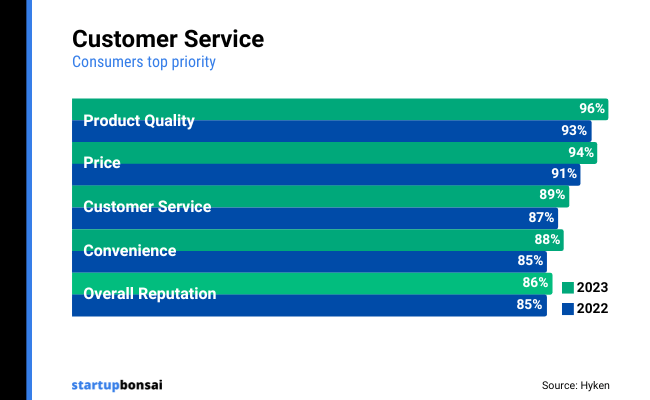
Source: Hyken
10. 88% of surveyed consumers say customer experience matters as much as the product
That’s right; customer service is so crucial that 88% of consumers see the experience you offer as equally important to the product. Interestingly, that’s up from 80% in 2020, reflecting increasing consumer expectations.
Source: Salesforce
11. 48% of consumers have switched brands for better customer service
If you’re not offering stellar customer service, you’re losing customers. It’s that simple.
Source: Salesforce
12. 94% of consumers say that good customer service makes them more likely to make a repeat purchase
Providing excellent customer service helps with customer retention, which can have a big impact on your bottom line. So it’s no wonder that 54% of customer service professionals say customer service is viewed by their company as a revenue generator rather than a cost.
Source: Salesforce
Customer service and consumer expectations
We’ve already talked a little bit about how consumers have higher expectations this year when it comes to customer service. Next, we’ll look at some stats that show exactly what it is they expect brands to do differently.
13. 73% of customers expect brands to understand their individual needs…
Consumers don’t want generic support and interactions – they want to know that brands understand and value them as an individual. That’s what good customer service looks like this year.
Source: Salesforce
14. …but 56% say most brands still treat them like numbers
Customers may feel that customer service is getting better on the whole, but when it comes to offering individualized support, they still think companies are falling short of the mark.
Source: Salesforce
15. 83% of consumers expect to interact with someone immediately upon contact
Speed is paramount when it comes to supporting your customers. If a customer contacts your customer service team, they expect you to respond straight away. And 83% expect that the first person they speak to will be able to resolve complex problems for them.
Source: Salesforce
16. 59% of consumers want businesses to use their data to personalize their customer experience
We’ve already talked about how consumers these days expect personalized service, but what’s interesting is that they’re willing to put aside their data privacy concerns for it. The majority of customers are happy for the brands they like to use their data for personalization, and 70% said they’ll spend more time with brands that offer personalized experiences.
Source: Zendesk
17. 59% of consumers prefer self-service support for simple issues/questions…
It’s that age-old question: Do customers prefer self-service support or to contact a customer service agent? According to this statistic, it looks like most prefer to find answers to their own questions via self-service as long as the problem is straightforward.
Source: Salesforce
18. …but 69% of surveyed consumers would prefer to speak to a live agent over self-service when they have a problem or issue with the company
This is according to a survey from Hubspot. Interestingly, much more people said they’d prefer to speak to a live agent when they have a problem this year than in 2021 (51%).
Source: Hubspot
19. 91% of consumers say convenience is the most important aspect of the customer experience
What does good customer service look like to the average consumer? Well, according to Hyken’s recent survey, 91% of consumers point to convenience as the most important aspect.
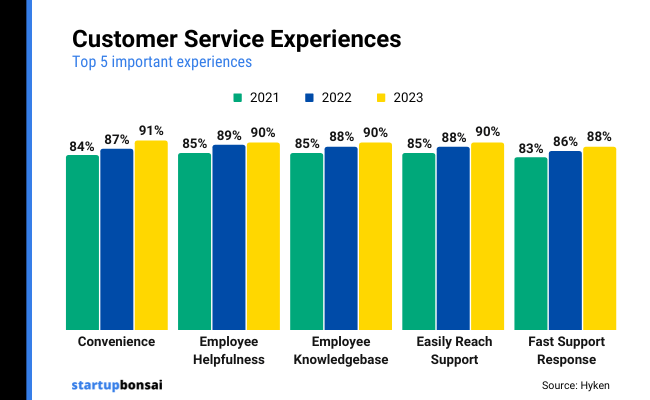
Next came helpful & kind employees (90%), knowledgeable employees (90%), able to easily reach the right support person (90%), and fast responses (88%)
Source: Hyken
20. 53% of consumers expect 24/7 customer service availability within the next 3-5 years
When asked how they expect/want to see customer service change in the near future, over half of surveyed customers said they expect 24/7 support availability, making this the top response.
Source: Hyken
How do customers react to bad service?
We’ve looked at the benefits that good customer service can bring to businesses. Now, let’s look at some stats that show the impact that bad customer service can have.
21. 66% of consumers said a bad support interaction can ruin their day
Put yourself in your customer’s shoes for a second. If you had an interaction with a brand that ruined your entire day, would you do business with that brand again? Yet roughly two-thirds of consumers said they’ve had that kind of interaction.
Source: Zendesk
22. 60% of consumers have bought something from one brand over another due to customer service
Customer service is a huge brand differentiator. All else being equal, providing good customer service could give you a real competitive edge in your market. But on the same note, providing bad customer service will leave the door open for your competitors to take your customers.
Source: Zendesk
23. 77% of customers said they’re likely to switch brands if they experience rudeness
Experiencing rudeness in an interaction with a brand is the top factor that’s likely to turn customers away.
Other relationship-ruining experiences noted by surveyed consumers include customer service staff not responding to their problem (77%), not making an effort to resolve their problem (77%), not listening or not understanding properly (74%), and transferring their support call to different people over and over again (70%).
Source: Hubspot
24. 77% of people who experience bad customer service will tell their friends and family
In addition, 62% will let someone at the company know that they had a poor customer service experience, and 61% will stop doing business with the company entirely. Only 22% will do nothing.
Source: Hubspot
25. 55% of customers have left a negative rating following a bad experience
Poor service can ruin your brand reputation and result in poor customer feedback. 55% of customers who have had a negative experience have left feedback in the form of a negative rating (using the 0-5 star system) as a result, and 47% have left a negative review (text comment).
Source: Hubspot
26. 37% say customers get frustrated when they can’t complete tasks on their own
The best customer service is proactive. Don’t wait for your customers to contact support; take steps to ensure that they don’t need to contact your support teams in the first place by making it easy for them to complete tasks on their own.
Source: Zendesk
27. 58% of agents think a lack of data causes negative experiences
If you want your customer service representatives to be able to do their job well, they need data to work with. If they don’t know enough about your customers, they can’t provide better, personalized experiences.
Source: Zendesk
28. 29% say customers have a negative experience if they can’t access basic information online
A lot of customers don’t want to have to speak to your support teams; they prefer to find answers on their own. And a huge point of frustration comes from a self-service gap – when brands don’t give them access to important information online.
Source: Zendesk
29. 90% of Americans will wait 5 minutes in a support call queue before getting frustrated
Response times matter, especially when it comes to phone support. Most customers find their patience starts to wear thin after 5 minutes in a call queue. Only 54% will wait 10 minutes before getting frustrated.
Likewise, 76% of Americans will wait up to 1 hour for an email support response before getting frustrated., but only 54% will wait for 3 hours
And 65% of Americans will wait for 10 minutes for a response over social media before getting frustrated, but only 36% will wait for 2 hours
Source: Hubspot
Customer service channels
What channels do brands use to offer customer service this year? Let’s find out.
30. Phone is still the most used customer service channel…
However, the meaning of ‘phone support’ is changing. It doesn’t necessarily refer to hardwired landline call centers anymore. 52% of agents now answer incoming support calls through a console/computer.
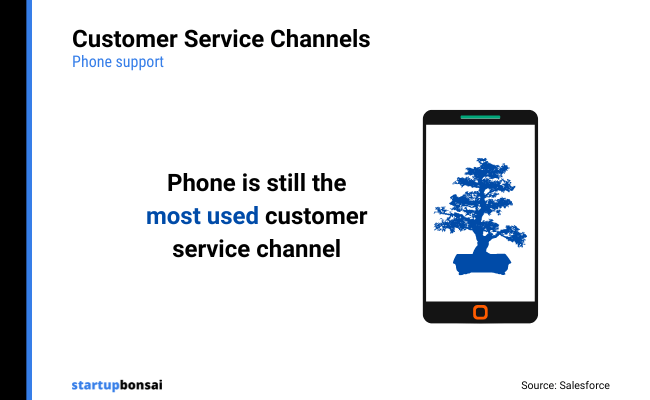
Source: Salesforce
31. …but the use of phones as a customer service channel is down 19% YoY…
While phones may still be the most widely-used channel, its popularity is beginning to wane. 96% of organizations reported offering phone support in 2020, compared to just 77% in 2022. Email is also down as a customer service channel, falling from 92% to 76%; and in-person service is down 75% to 74%.
Source: Salesforce
32. The use of video as a customer service channel is up 43% YoY
The number of brands that said they use video as a customer service channel increased from 46% in 2020 to 66% in 2022.
Other customer service channels that are up year over year include communities/discussion forums (up 30% YoY), mobile app (up 14% YoY), text (up 9% YoY), live chat (up 5% YoY), and social media (up 1% YoY).
This reflects changing consumer wants: 57% of customers now prefer to engage over digital channels.
Related reading: 25+ Top Video Marketing Statistics
Source: Salesforce
33. 83% of customers prefer to contact support via telephone
Telephone isn’t just the most popular customer service channel used by brands; it’s also the consumer’s favorite. 83% of customers prefer to get support over the phone, compared to 66% by email, 53% by online chat, 33% by text, 14% through the brand app, and 8% by social media
Source: Hubspot
Customer service agent statistics
Here are some interesting statistics about customer service agents and customer support staff.
34. 84% of customer service agents say their companies see them as brand ambassadors
That’s up from 77% in 2020. Brand ambassadors are individuals who represent and help spread the word of the company.
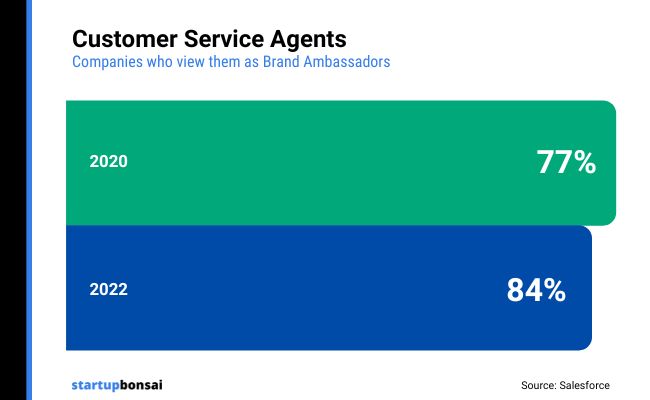
Source: Salesforce
35. Only 35% of customer service professionals work on-site
By on-site, we’re talking about working inside a company premises like their office/call center/store. 9% of surveyed customer service pros work from home, 33% work in the field, and 23% work in a hybrid model.
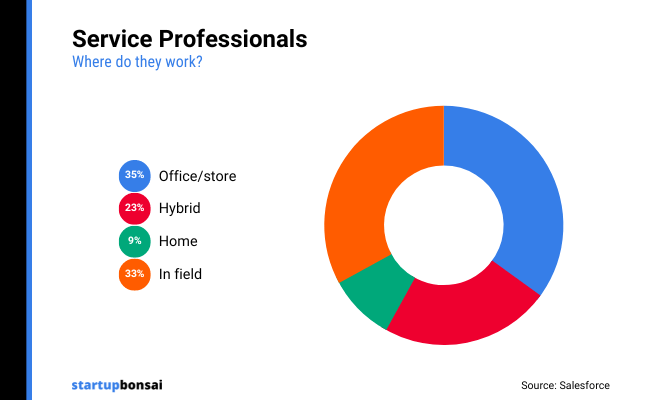
Source: Salesforce
36. 64% of customer support leaders say allowing flexible working conditions can boost morale
It’s not surprising so few customer service pros work on-site now, given that almost two-thirds of surveyed leaders think flexible working conditions boost morale. Other factors that leaders think boost morale amongst agents include adjusting workloads (54%) and investing in tech that helps with workload (52%).
Source: Intercom
37. 42% of customer support leaders say a drop in team morale negatively impacts performance
Happy agents are productive agents. Around 42% of leaders recognize that poor moral has a negative impact on performance, and 51% said that they’d seen a drop in morale over the few months before the survey was carried out.
Source: Intercom
Customer service metrics statistics
What metrics and KPIs matter most when it comes to customer service? Let’s find out.
38. The most commonly tracked metrics by customer service teams are DSAT (43.3%) and CSAT (38.1%)
Those acronyms refer to customer satisfaction scores and customer dissatisfaction scores. Other top tracked metrics include internal quality score (36.3%), first contact resolution rate (30.6%), and Net Promoter Score (28.2%).
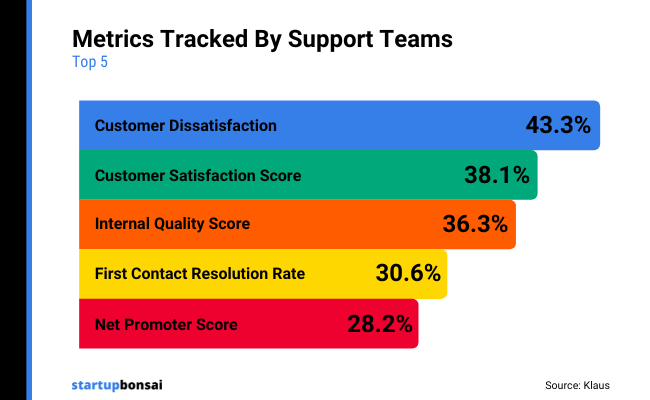
Source: Klaus
39. The average CSAT response rate is 19% for chat support
It’s even lower on email and phone (5% each). Additionally, in 19% of all CSAT ratings, the customer leaves both a score and a comment.
Source: Klaus
40. 74% of customer service organizations track customer satisfaction
This is as of 2022, per a report by Salesforce. Interestingly, this actually dropped from 87% in 2020 and 80% in 2018.
Source: Salesforce
41. 73% of customer service organizations track revenue
This makes revenue the joint-second most commonly used KPI to measure customer service performance identified in the Salesforce report. The other joint-second KPI was employee experience, which was also tracked by 73% of surveyed organizations.
Source: Salesforce
42. 72% of customer service organizations track customer retention.
This makes it the third most common KPI identified in the Salesforce study. Other metrics to round out the top 10 include average response time (71%), average handle time (71%), agent case volume (71%), SLA performance (70%), and first contact resolution (69%).
Source: Salesforce
43. The share of organizations that track case deflection is up 20%
67% of surveyed organizations in the latest survey said it was one of the KPIs they measured, compared to 56% in 2020 and just 36% in 2018.
Case deflection is a metric that shows the rate at which customers are able to resolve their own issues and find answers to questions that they would have otherwise had to call support for help with.
A high case deflection rate is a good signal of operational efficiency and may reflect an increasing focus amongst organizations to cut costs and be more efficient.
That would also explain why significantly more organizations are measuring other efficiency metrics like cost per contact this year.
Source: Salesforce
Customer service challenges
Here are some customer service statistics that highlight the challenges brands and agents face and the barriers that prevent them from creating a more positive customer service experience.
44. The number one challenge facing company’s customer service agents is dealing with upset customers
Hubspot asked service agents what their biggest challenges are in a recent survey, and the top response was ‘dealing with upset customers’. Around 50% of respondents from high-growth companies and around 57% of respondents from low-growth companies pointed to this.
Another top challenge noted by respondents was ‘not having enough time in the day’. This response was selected by 53% of surveyed agents from high-growth companies and 43% of those from low-growth companies.
Source: Hubspot
45. 33% of customer service agents say they often lack context about the customer’s situation
On the other hand, 67% of customer service agents say they always have a complete understanding of customer needs
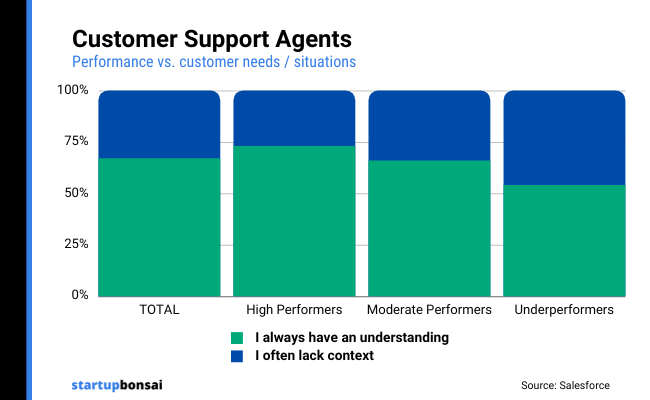
Source: Salesforce
46. 36% of customer service agents say restrictions prevent them from solving unique problems
These agents feel bound by company restrictions about what issues they can help with. On the other hand, 64% of customer service agents say they feel empowered by their company to treat customers with empathy.
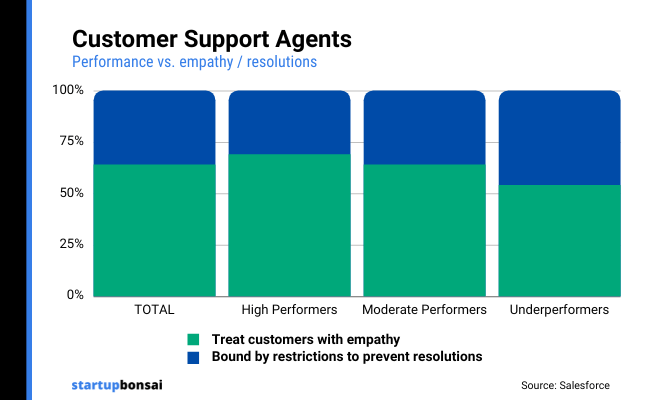
Source: Salesforce
47. 60% of customers say they feel like they’re communicating with separate departments rather than one company
And 66% say they have to repeat information to different agents often. This kind of cross-departmental communication is one of the biggest challenges brands must overcome if they want to create better customer experiences.
Source: Salesforce
48. 45% of underperforming customer service businesses say their customer service department is siloed.
In comparison, only 30% of high-performers say the same. The other 55% of underperforming agents and 70% of high-performing agents say customer support is connected to other departments in the business.
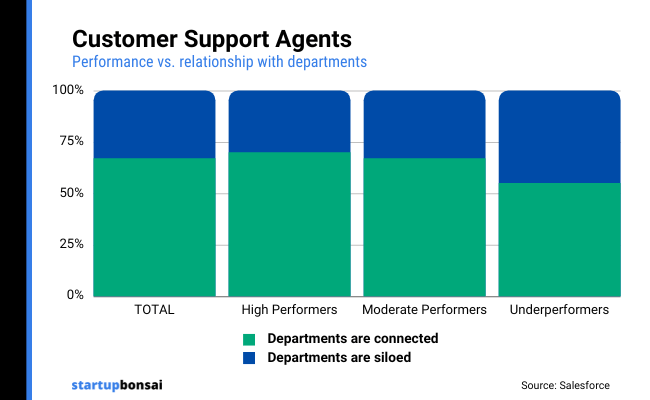
Source: Salesforce
Customer service software statistics
Here are a few interesting statistics about the software used in customer service.
49. 62% of customer service professionals say all their departments use the same CRM solution
CRM stands for customer relationship management software. According to this survey, the same CRM is used across different business departments in almost two-thirds of cases.
Source: Salesforce
50. 76% of support leaders think their tech stack is holding them back
59% say the problem is integration between tools not working seamlessly. And to fix this, 73% say one of their priorities for the next year is the interoperability of their tech stack.
Source: Intercom
51. 52.7% of surveyed professionals use communication tools for conversation reviews
Many businesses have a dedicated quality assurance team to help ensure top-notch customer support. Where this is the case, over half use communication tools to review agent conversations. Other tools used include customer service software (47.5%), dedicated QA software (44.4%), and spreadsheets (40.1%).
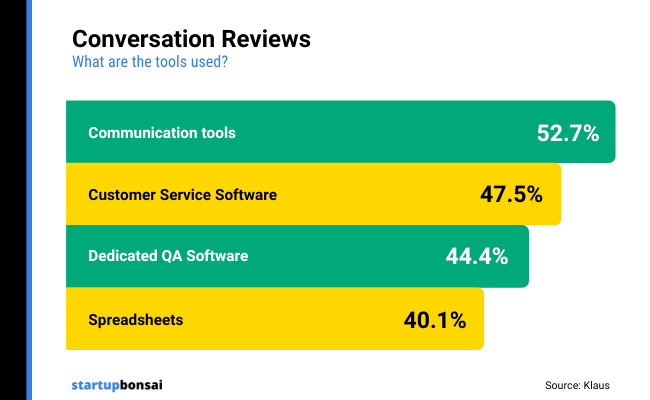
Source: Klaus
Customer service & AI
Artificial intelligence is becoming an increasingly important part of customer service. With rapid advancements in ML technology, service leaders are increasingly leading on AI chatbots and other tools to improve operational efficiency. Here are some stats that tell us more.
52. 65% of customer service leaders think their AI chatbots are becoming more human-like
And they are! Modern large language models allow chatbots to respond in a way that’s almost indistinguishable from a real human, improving customer interactions.
Source: Zendesk
Related reading: 25+ Top Chatbot Statistics
53. 77% of consumers say AI chatbots are helpful for resolving simple issues
Furthermore, 71% think AI chatbots reply faster, and 67% think AI bots provide accurate, correct information
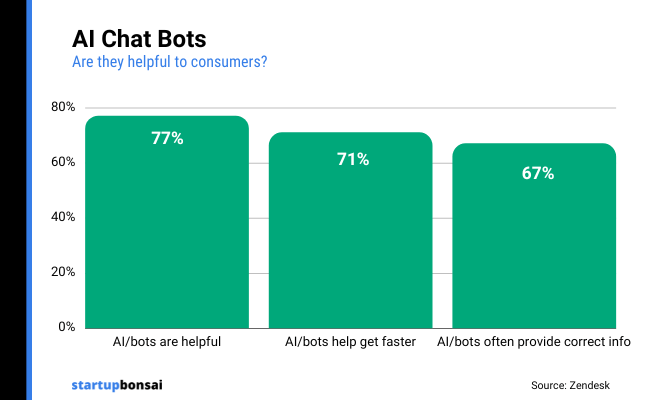
Source: Zendesk
54. 72% of business leaders say expanding AI usage for customer service will be important over the next year
Of these, 31% said it would be very important, and 41% said it would be somewhat important.
Source: Zendesk
55. 62% of business leaders say their companies are lagging behind in AI usage
Despite the clear benefits of AI, this stat shows that many brands have been sluggish in adopting it.
And more worrying still, 60% say they don’t have a strategic plan when it comes to AI, instead taking action ad hoc.
Source: Zendesk
56. 45% of customer service decision-makers report using AI
While still less than half, that’s significantly more than in 2020, when only 24% of respondents reported using AI.
Source: Salesforce
57. 64% of consumers would like bots to offer the same level of service as human agents
Customers seem to be welcoming advancements in AI chatbots, as almost two-thirds are looking forward to the day they can offer the same level of service as real humans.
Source: Zendesk
58. 70% of consumers say AI should be able to understand and respond to their emotions
One of the most frustrating parts of dealing with chatbots currently is that they can’t as easily sense the customer’s tone and mood or respond accordingly. Over two-thirds of surveyed consumers would prefer it if they could.
Source: Zendesk
59. 81% of consumers say that being able to be transferred to a human agent when having trouble with AI is critical to trust
And 78% of consumers want AI chatbots to summarize their issues to the agent they transfer them to so that they don’t have to repeat themselves.
Source: Zendesk
60. 63% of consumers think generative AI will revolutionize customer support
Generative AI is the buzzword this year. It refers to technology like ChatGPT that’s capable of generating original, unique content. And as this stat shows, consumers are hopeful that this tech will revolutionize the customer support industry.
Source: Zendesk
Sources
Final thoughts
That concludes our roundup of the top customer service stats and trends.
The key takeaway is that consumers are getting more demanding when it comes to the kind of experiences they expect from the brands they shop with. To keep pace with these demands, brands are increasingly focusing on personalization and connectivity.
And at the same time, they’re trying to save costs and improve operational efficiency in order to adapt to the current economic climate. One way this is being achieved is through the increasing adoption of AI technology to improve workflows.
We hope you found this interesting.
While you’re here, why not check out some of our other stat posts:
- Live chat statistics
- Sales statistics
- Business travel statistics
- Digital marketing statistics
- Customer retention statistics
- Shopping cart abandonment statistics
Thanks for reading!
